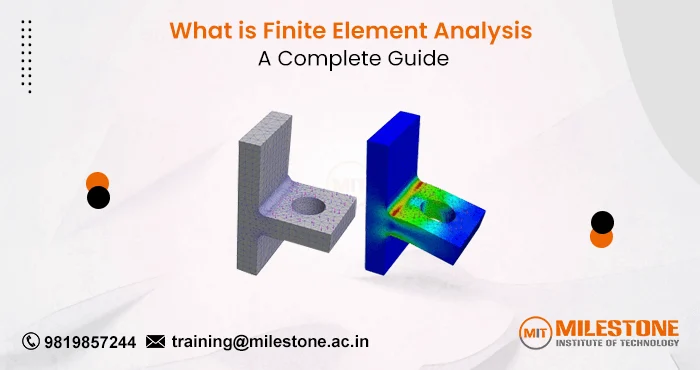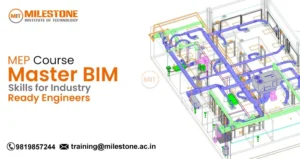Finite-Element Analysis (FEA) is a numerical technique which is used for finding solutions to integral equations. It divides complex structures into smaller and more simple elements called finite elements, which are then analyzed to predict the behavior of the whole system. It is a very common technique, which has been modeling system behavior for many different disciplines such as engineering (both industrial and systems) physics and manufacturing. In this guide we will be understanding
what is finite element analysis, how it works, important concepts, its applications, and benefits.
What is Finite Element Analysis (FEA)?
FEA is actually a numerical method which is used in solving engineering problems as well as scientific problems. Using this technique, a complicated system or structure is divided into smaller, more manageable components called finite elements. These components are generally joined at nodes. FEA applies mathematical equations, simulating how the structure behaves when it is subjected to different conditions (loads and temperatures etc.), using one or more finite elements.
This software basically brings the mechanics and materials science information together to predict how a structure will behave under certain scenarios. The findings afford valuable data for stress analysis, deformation and such other parameters which enable the engineers to take informed decisions regarding design & performance.
How Does Finite Element Analysis Work?
There are a few key steps in the FEA process:
Pre-Processing:
- Model Creation: The first step consists of creating a digital model corresponding to the structure or system under analysis. This will consist of geometry, material details and border sections.
- Meshing: It is the process of breaking down a model into parts. Each element defines its geometry (i.e., tetrahedral, hexahedral) and its corner nodes. The quality of the mesh considerably impacts the accuracy of the results.
Solution:
- Applying Loads and Boundary Conditions: The model is then subject to external forces, temperatures and boundary conditions. These are more real-world like scenarios.
- Solving the System of Equations: The FEA software solves the system of linear (or nonlinear) equations defining each element. It is the step of how the entire structure reacts, through complex mathematical analysis.
Post-Processing:
- Result Visualization: Once they arrive at the solution, they simply plot a graphical representation of their outcome. This allows engineers to see how stress distributions, deformations and other key features change throughout the life of a structure.
- Interpretation: Researchers use a comprehensive analysis of the results to interpret how well the structure performs and to detect unresolved issues. The engineers use that data to carry out design improvements or validations required by the final specifications.
Key Concepts in Finite Element Analysis
Mesh Quality:
- Element Types: Elements such as triangular and quadrilateral shapes are based on the geometry of the model. The element type you are using also has an impact on the accuracy and efficiency of your analysis.
- Refinement: This requires special interpretation of the result, as finer mesh (more elements) allow more accuracy while excessive refinements can consume a great amount of computing power. In general, engineers apply mesh refinement to high-stress regions or locations with complex geometry.
Material Properties:
- Elasticity: Most of the time, engineers consider materials to be linear elastic (as soon as they remove the load, the material regains its initial shape). However, they can also model nonlinear materials.
- Thermal Properties: When performing a thermal analysis, we will include the material properties such as thermal conductivity and specific heat.
Boundary Conditions:
- Fixed Supports: These is the main points or regions on which the structure is fix.
- Load Applications: There are various ways to induce loads such as forces, pressures or temperatures.
Solution Methods:
- Linear Analysis: When material and structural response is linear Appropriate for problems that have little deformation and linear elasticity properties.
- Nonlinear Analysis: It is use when dealing with large deformations, nonlinear material properties, or complex boundary conditions.
Applications of Finite Element Analysis
FEA is a national practice common to many industries around the world for handling some of today’s most challenging engineering problems. Here are the following list of common use-cases and applications:
Structural Analysis:
- Buildings and Bridges: Engineers use FEA to understand the stress and deformation behavior of structures under different loads for safety & stability.
- Aerospace: Engineers use FEA to model aircraft structures that must withstand aerodynamic forces and vibrations.
Mechanical Components:
- Automotive Industry: Engineers mainly use FEA to analyze the thermal performance, crashworthiness, and fatigue of automotive components or parts.
- Manufacturing: Design of tools and mechanisms improves efficiency & minimizes wear.
Thermal Analysis:
- Heat Transfer: FEA use in analyzing heat distribution of electronic devices, different machinery or precision structure.
- Cooling Systems: Engineers simulate the cooling systems for these designs to ensure they sufficiently release heat.
Fluid Dynamics:
- CFD (Computational Fluid Dynamics): Like FEA, engineers often combine CFD (Computational Fluid Dynamics) with stress analysis problems that involve fluid flow around structures, such as those in aerospace and automotive industries.
Benefits of Finite Element Analysis
Accuracy and Precision:
Detailed Insights: The FEA model provides access to information such as stress, strain, and deflection, which physical testing alone often cannot detect.
Cost-Effective:
Design Optimization: FEA allows to identify the problems in a design at an early stage of development, thereby minimizing expensive physical prototyping and testing.
Design Flexibility:
Iterative Design: Engineers can tweak the model and run simulations again to investigate various design alternatives, thereby optimizing performance.
Complex Problem Solving:
Handling Complexity: FEA is a superior option when dealing with complex geometries, boundary conditions and material behaviors which are difficult for solution by classical analytical methods.
Challenges and Limitations
- Computational Resources: Finite Element Analysis Method (FEA) needs good computational capacity especially in large and complex models. As a result, it can cause long simulation times and expensive hardware/software costs.
- Mesh Sensitivity: Since the mesh quality is a big factor on how accurate your results will be. A poor mesh design might cause errors in the answer.
- Model Assumptions: Many times, FEA models are simplified and assumptions to help connect the dots between simulation set-up and accuracy-values.
- User Expertise: Proper utilization of FEA requires a clear understanding of the fundamentals, correct modeling and result reading techniques.
Where to Learn FEA?
When it comes to learning FEA and CFD, there are many institutes which provide training and cover these essential topics. As per the research, Milestone Institute of Technology offers a complete engineering courses such as
SolidWorks simulation, Ansys and many more which covers these crucial topics. Their faculties provide practical training and personal guidance which help students to gain proper knowledge and skills.
Frequently Asked Questions
What are the most common software tools which are used for Finite Element Analysis?
There are several software tools that people use for Finite Element Analysis such as
ANSYS, Abaqus, COMSOL Multiphysics and SolidWorks Simulation. Although these different tools have a lot of features used for building the models, load and boundary conditions application, solving equations as well generating plots/result viewing. The needs of the analysis and user experience, as well as familiarity with a specific tool, typically determine which software to use.
What types of problems can be solved using Finite Element Analysis?
Many types of engineering problems can be solved with FEA, such as structural analysis (the stress and deformation in a beam or bridge), thermal analysis (heat transfer through an electrical component), fluid dynamics(dynamic airflow over aircraft wing etc.) Individual can utilize it for linear as well as non-linear problems, and it works over complex geometries and boundary conditions.
How does FEA compare to traditional analytical methods?
FEA provides a more detailed and accurate analysis of complex structures compared to traditional analytical methods, which often rely on simplified assumptions. While analytical methods may be suitable for straightforward problems, FEA can handle complex geometries, varying material properties, and multiple load conditions, offering more comprehensive insights into structural behavior.




